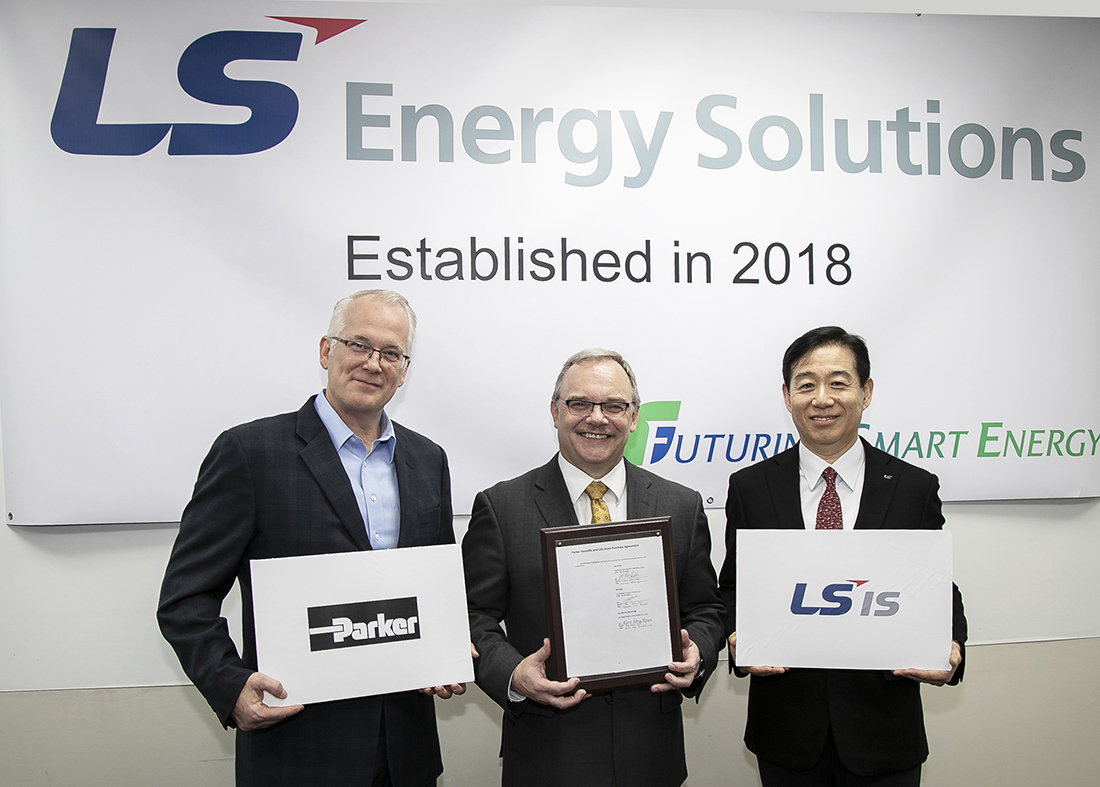MEDIA
LS NEWS
LSIS Acquires ESS Unit of North America’s ESS leader Parker-Hannifin
LSIS2018-12-05
■ With the takeover of the EGT unit, LSIS sets up LS Energy Solutions in North America
■ Chairman Ja-kyun Koo: “Our North American subsidiary will not only remain a solid leader in North America but also emerge as a dominant player in the global ESS market.”
■ The global sales network and the combined production, R&D, and HR resources are expected to maximize the synergistic effects
■ Chairman Ja-kyun Koo: “Our North American subsidiary will not only remain a solid leader in North America but also emerge as a dominant player in the global ESS market.”?
LSIS has accelerated its bid to tap into the global market by taking over the energy grid tie (EGT) business of Parker-Hannifin, the energy storage system (ESS) leader in North America.
LSIS said on December 5, 2018 that it signed a contract with Parker Hannifin to acquire the entirety of both tangible and intangible assets including production facilities and personnel of the latter’s EGT unit and set up LS Energy Solutions as its subsidiary operating in North America in order to compete in the global ESS market better.
Launched in 2007, the EGT unit of Parker-Hannifin is deemed to possess core technologies including world-class ESS systems and PCS designs as well as production, operation, and services technologies.
With these technologies, the company quickly expanded its sales not only in North America but also in other parts of the world including Europe, Central and South America, Australia, and Southeast Asia. As a result, it emerged as the No. 1 ESS supplier in North America with accumulated sales exceeding 400 MW (PCS).
Following the acquisition, LS Energy Solutions was set up in Charlotte, North Carolina as a subsidiary of LSIS.
Bringing together the world’s top-quality products and the technologies of the two companies, the deal is expected to upgrade the capacity of the smart energy business including ESS, which will subsequently help step up its global expansion.
In particular, the setup of the sub-subsidiary company will increase the accumulated supply to 700MW, and the company will be able to rank second in global ESS PCS sales, with the world’s largest reference in the industrial ESS market.
Furthermore, once global sales networks including Korea, US, Asia, Central and South America, Europe, and Australia, production and R&D facilities, and human resources of the two companies are combined, LSIS will be equipped with much stronger capability to develop and manufacture strategic new products. With the enhanced capability and resources, the company plans to embark on aggressive sales expansion campaigns in the global market beyond North America.
“When the innovative smart energy technologies of LSIS and the client base and technological know-how of LS Energy Solutions are brought together under the deal, we will be able to secure a strong base for global expansion. We expect to see tangible results initially in North America as our strategic global market,” said Ja-kyun Koo, CEO of LSIS.
Koo added that the accumulated ESS supply will reach 125 GW by 2030 -- which is approximately 66 times more than that of 2016 -- with 8 countries including Korea, US, and China to constitute around 70% of the total sales. “Our long-term goal is to preoccupy global markets with proactive investments and become a trendsetting global player,” Koo added.
New renewable energy is vulnerable because its production and supply fluctuate according to changes in the external environment. In order to address this vulnerability and ensure stable supply of electricity, it is essential to link to ESS so that extra electricity is stored and can be used later when demand is high.
Since the use of new renewable energy is becoming widespread globally, the ESS market is growing at a fast pace.
In its Global Energy Storage Outlook, Bloomberg New Energy Finance predicted that 103 billion dollars would be invested in the ESS market from 2016 to 2030, and that the global ESS market would grow 40% in 2019 to 17GWh (batteries) from 2018.
In particular, the leading US and European markets are expected to see steep growth from 1.6 billion dollars in 2016 to 18.4 billion dollars in 2025.
-
LS Cable & System first Korean company to enter growing Taiwanese submarine power cable market
LS Cable&System2019-01-07 -
LSIS Acquires ESS Unit of North America’s ESS leader Parker-Hannifin
LSIS2018-12-05 -
LS Cable & System seizes Grand Prize in Printed Company Newsletter Special Sector at the ‘2018 Korea Communication Awards’
LS Cable&System2018-12-04 -
LS Cable & System completes the construction of the Myanmar power cable plant
LS Cable&System2018-11-14 -
LS Cable & System and Donghae hold annual ‘Share Kimchi of Love’ event
LS Cable&System2018-11-09